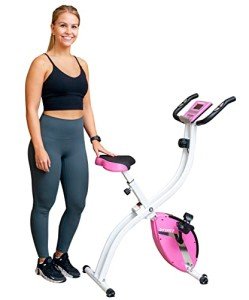The Ultimate Guide to Fitness Cycles for Home Workouts
In recent years, the trend of home workouts has actually grown, driven by the pursuit of health, health, and benefit. Stationary Bikes Online of the most popular tools is the fitness cycle. Not only do they offer the benefit of exercising at home, however they also offer several benefits that contribute to total fitness and wellness. This post explores the benefits of utilizing a fitness cycle, the different types available, and suggestions on how to pick the best one for your needs.
Benefits of Using a Fitness Cycle
1. Cardiovascular Health
Riding a fitness cycle is an excellent way to take part in cardiovascular exercise. It raises heart rate, improving blood flow and improving heart health. Regular cycling can help prevent cardiovascular disease, lowering cholesterol levels, and controlling blood pressure.
2. Low Impact Exercise
Unlike lots of high-impact workouts, cycling is gentle on the joints. This makes it a suitable alternative for those recuperating from injuries or those with joint pain, allowing them to engage in effective aerobic activities without triggering more tension on their bodies.
3. Variable Intensity Levels
Fitness cycles frequently come geared up with adjustable resistance levels, permitting users to customize their workout strength. Whether you are a beginner or an experienced professional athlete, you can effortlessly change the settings to match your fitness goals.
4. Convenience and Flexibility
A fitness cycle in the house eliminates the requirement for gym subscriptions and long travel times. This convenience enables users to fit workouts into their schedules more easily, improving adherence to a fitness regimen.
5. Versatile Training Options
With a fitness cycle, individuals can take part in various training designs, such as steady-state cycling, high-intensity period training (HIIT), or endurance training. The flexibility makes sure that workouts remain varied and engaging.
Kinds Of Fitness Cycles
When choosing a fitness cycle, it is necessary to understand the different types offered in the market. Here are the most typical categories:
1. Upright Bikes
- Description: Designed likewise to conventional bicycles, upright bikes require users to maintain an upright position.
- Pros: Great for imitating outdoor cycling; generally more compact.
- Cons: Might be uncomfortable for longer trips.
2. Recumbent Bikes
- Description: These bikes have a bigger seat and a reclined position that supplies more back support.
- Pros: More comfy for many individuals; ideal for users with back issues.
- Cons: Takes up more area; might not provide as intense a workout as upright models.
3. Spin Bikes
- Description: Designed for high-intensity exercises, spin bikes resemble those utilized in indoor cycling classes, including a heavy flywheel for smooth pedaling.
- Pros: Offers a challenging workout; excellent for those who delight in group classes.
- Cons: Generally less comfy; not perfect for leisurely cycling.
4. Air Bikes
- Description: These bikes utilize a fan for resistance, meaning the harder you pedal, the more resistance you experience.
- Pros: Provides a full-body workout; outstanding for high-intensity training.
- Cons: Noisy; needs more effort and endurance.
How to Choose the Right Fitness Cycle
With many choices available, selecting the ideal fitness cycle can be challenging. Here are some key factors to consider when making your decision:
1. Area and Size
- Examine how much area you have readily available for the cycle. Measure the area and compare it with the measurements of various bikes.
2. Budget plan
- Fitness cycles vary in cost. Figure out a budget and search for models that fit within that range while satisfying your requirements.
3. Functions
- Search for additional features that fit your workout style, such as adjustable handlebars, seat convenience, built-in workout programs, and tracking systems.
4. User Weight Capacity
- Ensure the bike can support the weight of all possible users. Many fitness cycles indicate a maximum user weight capability, normally varying from 250 to 400 pounds.
5. Warranty and Support
- Consider the maker's service warranty and customer care choices. An excellent guarantee can safeguard your financial investment in case of problems or problems.
Frequently Asked Questions (FAQs)
Q1: Do I require a bike mat for my fitness cycle?
Yes, a bike mat can safeguard your floor from scratches and help keep the bike steady during workouts.
Q2: How often should I ride my fitness cycle?
For ideal health benefits, aim for a minimum of 150 minutes of moderate activity or 75 minutes of vigorous activity each week.
Q3: Can fitness cycles assist with weight loss?
Absolutely! Routine cycling can assist burn calories and fat, contributing to weight loss when combined with a well balanced diet.
Q4: Are fitness cycles beneficial for novices?
Yes, fitness cycles are great for beginners as they allow users to start at a comfy speed, gradually increasing strength as fitness improves.
Q5: How do I preserve my fitness cycle?
Routinely inspect and tighten bolts, tidy the frame, and lube the moving parts to ensure appropriate working and longevity.
A fitness cycle can be an exceptional addition to any home workout program, providing many health advantages while offering benefit and versatility. By comprehending the various types offered and thinking about personal needs, individuals can choose the best model to boost their fitness journey. With the potential to cultivate a regular exercise routine, purchasing a fitness cycle is a step towards a healthier way of life. Whether the goal is to improve cardio fitness, drop weight, or improve general well-being, a fitness cycle can yield fantastic results when made use of successfully.

